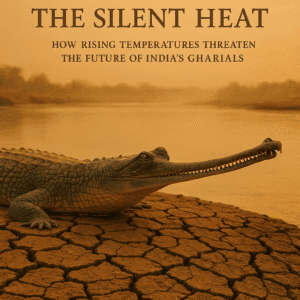The Silent Heat: How Rising Temperatures Threaten the Future of India’s Gharials
Rising nest temperatures in India’s National Chambal Sanctuary threaten to catastrophically skew the sex ratio of critically endangered gharial crocodiles. Unlike mammals, gharial gender is determined by incubation heat – with males only developing reliably near 32°C. Recent research reveals nests now consistently exceed this threshold, averaging temperatures likely producing three females for every male. Over a third of monitored nests reached levels predicted to yield exclusively female hatchlings.
This imbalance poses an existential threat: while gharials are naturally polygynous (one male mates with multiple females), severely depleted male numbers could collapse breeding groups through genetic bottlenecks and inbreeding. The phenomenon represents a silent, insidious pressure layered atop existing threats like habitat loss and fishing nets. Ultimately, climate change isn’t just altering environments—it’s reprogramming the fundamental biology of survival for this ancient species, potentially undermining decades of direct conservation efforts.

The Silent Heat: How Rising Temperatures Threaten the Future of India’s Gharials
Imagine the banks of the Chambal River in India, where a prehistoric survivor, the critically endangered gharial crocodile, lays its eggs in carefully constructed nests of sand and vegetation. For millennia, this ritual ensured the species’ survival. But today, a new, insidious threat is warming these nests from within, potentially rewriting the future of these unique creatures: climate change-driven heat is skewing the sex ratio of hatchlings towards females at an alarming rate.
Unlike humans, where sex is determined by chromosomes, gharials (along with other crocodilians and sea turtles) rely entirely on nest temperature during a critical incubation window. This delicate thermal dance, nature’s quirky blueprint for balance, is now being disrupted:
- The Goldilocks Zone for Males: Research led by Surya P. Sharma of the Wildlife Institute of India reveals a narrow band of near-perfect conditions. Temperatures hovering around 32°C (89.6°F) predominantly produce male hatchlings.
- The Female Tipping Point: Stray just half a degree cooler (≤31.5°C / 88.7°F) or climb above 33.5°C (92.3°F), and the odds swing decisively towards females.
The Chambal River Study: Measuring the Heat Shift
Between 2017 and 2019, scientists meticulously monitored 17 gharial nests within the vital National Chambal Sanctuary in Madhya Pradesh. Temperature loggers embedded at different depths within each nest painted a concerning picture during the crucial sex-determination phase (days 20-40 of incubation):
- Recorded temperatures fluctuated between 30.5°C and 34.0°C (86.9°F – 93.2°F).
- Analysis of this data predicts a stark imbalance: an average ratio of three female hatchlings for every one male.
- Disturbingly, over 35% of nests experienced temperatures consistently high enough to potentially produce only females. Three nests fell squarely into this category.
The Invisible Crisis: Confirmation Challenges and Long-Term Peril
A poignant challenge underscores the research: visually confirming the sex of tiny gharial hatchlings is currently impossible. Researchers must wait years until the animals are large enough for reliable techniques. “Even without physically sexing every hatchling,” Sharma emphasizes, “the field observations strongly suggest a female-biased sex ratio emerging in these populations.”
This isn’t just an abstract statistic; it’s a fundamental threat to the species’ survival:
- Polygyny Under Pressure: Gharials are polygynous – one male can mate with multiple females. While this system can tolerate some female bias, the predicted extreme skew (3:1) shatters the balance.
- Shrinking Effective Population: Fewer males mean fewer individuals actually contributing genetically to the next generation. This drastically shrinks the “effective breeding population,” far below the total headcount.
- Genetic Erosion & Collapse: A small number of breeding males leads to increased inbreeding, especially in fragmented populations like the gharial’s. This erodes vital genetic diversity over time, weakening the population’s resilience to disease and environmental change.
- Breeding Group Failure: In isolated habitats, the lack of sufficient males could cause entire local breeding groups to collapse, pushing the species closer to extinction.
A Symptom of a Larger Struggle
The temperature threat compounds existing perils. Gharials, uniquely adapted fish-eaters with their slender snouts, already face decimation from habitat loss due to sand mining and dams, drowning in fishing nets, and poaching. Climate change, manifested in rising ambient and nest temperatures, adds a pervasive, slow-burning pressure that could undermine conservation efforts focused on these other threats.
The Human Insight: Beyond the Numbers
This isn’t merely a crocodile problem; it’s a stark warning about the subtle, cascading consequences of a warming planet. The gharial’s plight illustrates how climate change disrupts fundamental biological processes – processes evolution perfected over millions of years but that are now vulnerable to rapid anthropogenic change. It highlights that conservation isn’t just about protecting adults from direct harm; it’s about safeguarding the entire lifecycle, including the unseen environmental conditions that determine the very makeup of future generations.
The silent heat rising through the sands of the Chambal is a race against time. Long-term monitoring is crucial to definitively confirm the sex ratios and track trends. More importantly, it underscores the urgent need for holistic conservation strategies that integrate habitat protection, mitigation of direct threats, and climate resilience planning. The future of the gharial, an irreplaceable thread in India’s biodiversity tapestry, depends on recognizing and acting against this thermal threat before the delicate balance of life tips irrevocably.
You must be logged in to post a comment.